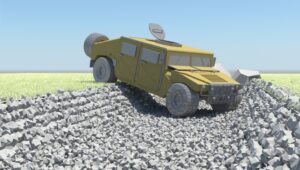Collision detection is a fundamental task in computer simulations, widely applied in robot dynamics simulations and game engines. In large-scale granular simulations, collision detection faces two key challenges: firstly, due to small particle sizes and high stiffness, extremely small time steps (such as 1×10⁻⁶ to 1×10⁻⁵ seconds) are required to ensure numerical stability; secondly, collision detection typically involves enormous computational effort, becoming a significant bottleneck in large-scale simulations.
To address these challenges, the literature has proposed various parallel collision detection strategies, including algorithms such as grid hashing, sweep and prune, analytical methods, and Minkowski Portal Refinement (MPR) implemented with OpenMP and GPU acceleration, as well as asynchronous decoupling of contact detection and dynamics solving.
This thesis aims to integrate the above parallel techniques into a multibody dynamics simulation framework to achieve efficient large-scale collision detection. The research begins with a comprehensive literature review of state-of-the-art parallel collision detection algorithms, followed by the implementation of selected methods in a C++ simulation platform. Finally, the performance and scalability of the implemented methods are evaluated through benchmark case studies.
Keywords: Collision Detection, GPU Computing, Dynamics Simulation, Game Engine

Requirements:
-
You are studying Electrical Engineering, Automation, or Robotics Systems Engineering.
-
You are interested in robot simulation or game physics engines; ideally, you have studied multibody dynamics or robotics dynamics.
- Ideally, you have programming skills in C++
Betreuer: Shao, Email:





